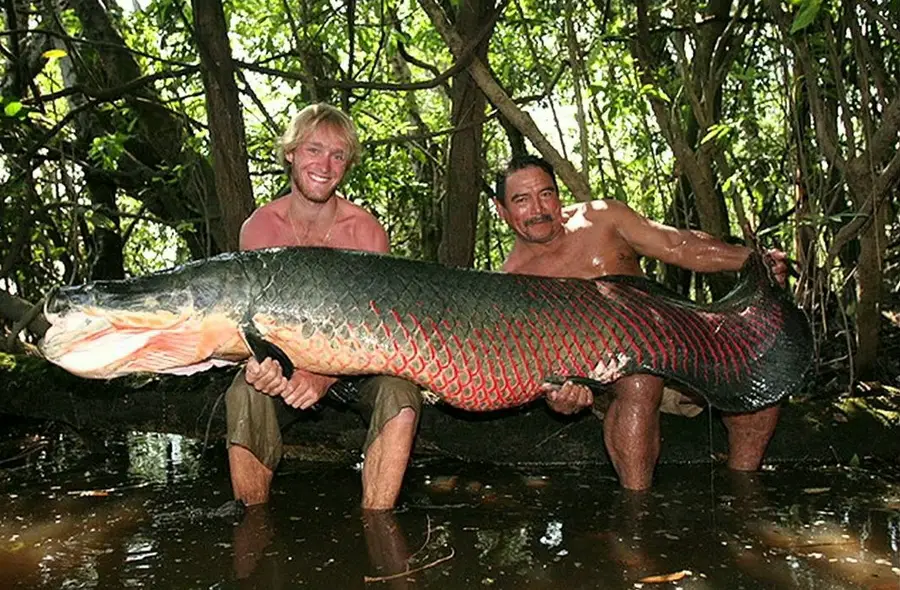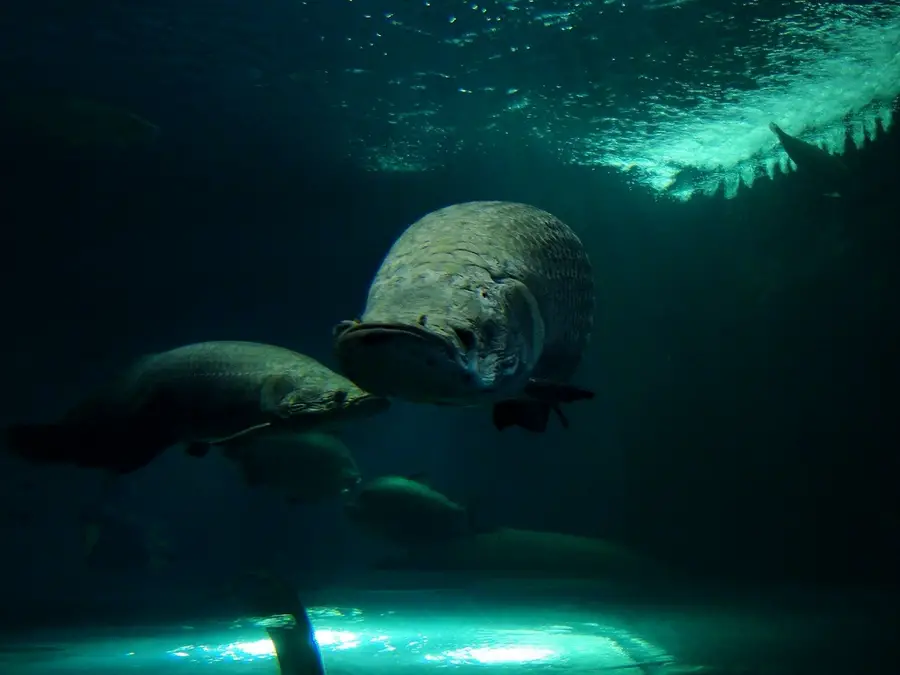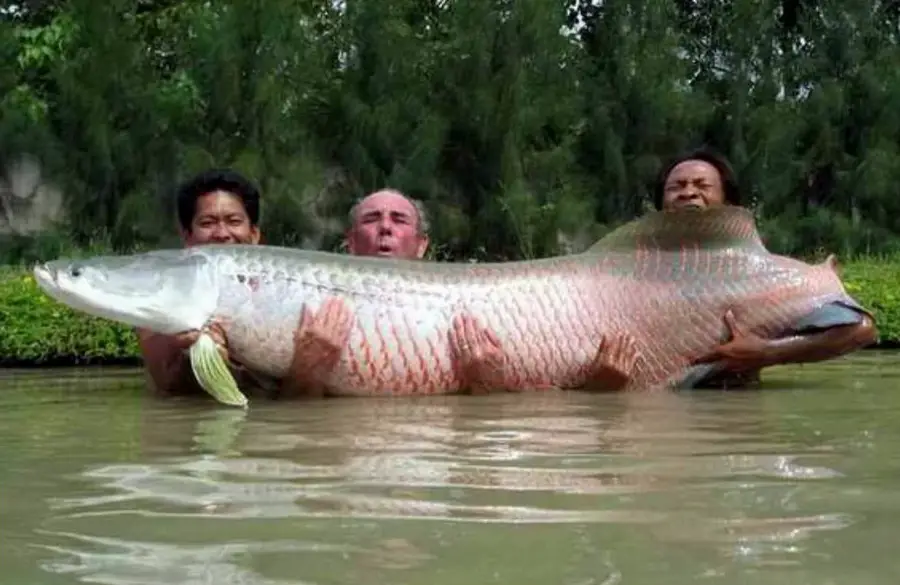The giant arapaima is one of the largest and least studied fish in the world. The descriptions of fish that are found in the literature are borrowed mainly from the unreliable stories of travelers.
It is even strange how little has been done so far to deepen our knowledge of the biology and behavior of the arapaima. For years, it was mercilessly fished both in the Peruvian and Brazilian parts of the Amazon and in its many tributaries. At the same time, no one cared about studying it and did not think about preserving it. The schools of fish seemed inexhaustible. And only when the number of fish began to noticeably decrease, there was interest in it.

Arapaima is one of the largest freshwater fish in the world. Representatives of this species live in the Amazon basin in Brazil, Guyana, and Peru. Adults reach 2.5 m in length and weigh up to 200 kg. The uniqueness of arapaima is the ability to breathe air. Due to its archaic morphology, the fish is considered a living fossil. In Brazil, fishing is only allowed once a year. Initially, the fish was harvested with harpoons when it rose to breathe on the surface.
In Brazil, giant fish were settled in ponds in the hope that they will take root there. In eastern Peru, in the jungles of the province of Loreto, certain areas of rivers and a number of lakes have been left as a reserve fund. It is allowed to fish here only under the license of the Ministry of Agriculture.
Arapaima is found throughout the Amazon basin. To the east, it is found in two areas separated by the black and acidic waters of the Rio Negro. In Rio Negro, arapaima is not found, but the river, apparently, is not an insurmountable barrier for fish. Otherwise, one would have to assume the existence of two species of fish with different origins and living north and south of this river.
The western region of the distribution of arapaima is probably Rio Moro-na, to the east of it Rio Pastasa and Lake Rimachi, where a huge number of fish are found. It is the second protected reservoir in Peru for breeding and observation of arapaima.
An adult arapaima is painted very picturesquely: its back color changes from bluish-black to metallic green, belly – from cream to greenish-white, sides and tail are silvery-gray. Each of its huge scales shimmers with all sorts of shades of red (in Brazil, the fish is called pirarucu, which means redfish).
Arapaima is one of the largest freshwater fish. There were specimens 4.5 m long! Now you will not find such people. Since 1978, the record of the Rio Negro River (Brazil) has been held, where arapaima was caught with a data of 2.48 m – 147 kg (the price of a kilogram of tender and tasty meat, almost without bones, far exceeds the monthly income of Amazonian fishermen. can be seen in antique shops).
This strange creature looks like a representative of the era of the dinosaurs. Yes, it is so: a living fossil has not changed in 135 million years. The tropical Goliath has adapted to the swampy swamps of the Amazon basin: the bubble attached to the esophagus acts like a lung, arapaima protrudes out of the water every 10-15 minutes. She kind of “patrols” the Amazon basin, captures small fish in her mouth, and grinds them with a bony, rough tongue (the locals use it as sandpaper).
These giants live in the freshwater bodies of South America, in particular in the eastern and western parts of the Amazon basin (in the Rio Moron, Rio Pastasa, and Lake Rimachi rivers). A huge amount of arapaima is found in these places. In the Amazon itself, there are not so many of these fish, it prefers quiet streams with a weak current and a lot of vegetation. A pond with rugged shores and a large number of floating plants is the ideal place for her to live and exist.
According to local residents, this fish can reach 4 meters in length and weigh about 200 kilograms. But arapaima is a valuable commercial fish, so now there are practically no such huge specimens in nature. Nowadays, specimens of no more than 2-2.5 meters are most often found. Still, giants can be found, for example, in special aquariums or reserves.
Previously, arapaima was caught in large quantities and did not think about its population. Now, when the stocks of these fish have significantly decreased, in some countries of South America, for example in eastern Peru, areas of rivers and lakes have been identified, which are strictly protected and fishing in these places is allowed only under the license of the Ministry of Agriculture. And even then in limited quantities.
An adult can reach 3-4 meters. The powerful body of the fish is covered with large scales that shimmer in various shades of red. This is especially noticeable in its tail part. For this, the locals gave the fish another name – pirarucu, which translates as “redfish”. The fish themselves are of different colors – from “metallic green” to bluish-black.
Her respiratory system is quite unusual. The fish’s pharynx and swim bladder are covered with lung tissue, which allows the fish to breathe normal air. This adaptation has developed due to the low oxygen content in the waters of these freshwater rivers. Thanks to this, arapaima can easily survive drought.
The manner of breathing of this fish cannot be confused with anyone. When they rise to the surface for a breath of fresh air, small eddies begin to form on the water surface, and then the fish itself appears in this place with a huge open mouth. All this action lasts just a couple of seconds. It lets out the “old” air and takes a new sip, the mouth closes abruptly and the fish goes to the depths. Adults breathe like this every 10-15 minutes, young ones – a little more often.
On the head of these fish, there are special glands that secrete special mucus. But what it is for, you will find out a little later.
These giants feed on bottom fish, sometimes they can eat small animals, such as birds. In juveniles, the main dish is freshwater shrimp.

The breeding season for Piraruku is in November. But they begin to create pairs already in August-September. These giants are very caring parents, especially males. Here I immediately remembered how the male “sea dragons” take care of their offspring. These fish do not lag behind them. The male digs a shallow hole about 50 centimeters in diameter near the coast. The female lays eggs in it. Then, during the entire period of development and maturation of eggs, the male is next to the clutch. He guards eggs and swims near the “nest”, while females drive away fish swimming nearby.
After a week, fry is born. The male is still next to them. Or maybe they are with him? Young animals keep in a dense flock near his head, and even to breathe they rise together. But how does a male manage to discipline his kids like that? There is a secret. Remember, I mentioned special glands on the head of adults. So, the mucus that is secreted by these glands contains a stable substance that lures the fry. This is what makes them stick together. But after 2.5-3 months, when the young grow up a little, these flocks disintegrate. The bond between parents and children is weakening.
Once the meat of these monsters was the staple food of the peoples of the Amazon. Since the late 1960s, in many rivers, arapaimas have disappeared altogether: after all, only large fish were killed with a harpoon, while nets were allowed to catch babies. The government has banned the sale of arapaima less than one and a half meters long, but the taste, which only trout and salmon can rival, pushes people to break the law. It is promising to breed arapaima in artificial pools with heated water: they grow as much as five times faster than carp!
The distribution of arapaima in certain areas of the river depends, apparently, more on the vegetation growing there than on the nature of the water itself. Fish requires a heavily indented coast with a wide strip of coastal floating plants, which, intertwining, form floating meadows.
For this reason alone, fast-flowing rivers like the Amazon are not suitable for the existence of arapaima. The bottom of the Amazon always remains smooth and uniform, so there are few floating plants, the same as there are, usually entangled among shrubs and hanging branches.
On Rio Pakai, we found arapaima in backwaters, where, in addition to floating meadows of aquatic grasses, floating mimosas and hyacinths grew. In other places, these species could be replaced by floating ferns, Victoria-Regia, and some others. The giant fish is invisible between the plants.
Perhaps not surprisingly, arapaimas prefer to breathe air rather than oxygen from the swampy waters in which they live.
The manner of inhaling air is very characteristic of the arapaima. When a large fish approaches the surface, a whirlpool first forms on the water surface. Then the fish itself suddenly appears with its mouth open. It quickly releases air with a clicking sound, inhales fresh air, and immediately plunges into the depths.
By the whirlpool formed on the surface of the water, fishermen hunting for arapaima determine where to throw the harpoon. They throw their heavy weapon right into the middle of the whirlpool and in most cases miss the target. But the fact is that the giant fish often lives in small reservoirs, 60-140 meters long, and eddies are formed here all the time, and consequently, the likelihood of the harpoon getting into the animal increases. Adults appear on the surface every 10-15 minutes, young ones more often.
Having reached a certain size, arapaima goes to the fish table, specializing mainly in bottom shellfish. In the stomachs of arapaima, the spiky needles of the pectoral fins of these fish are most often found.
In Rio Pakai, obviously, the conditions for arapaima life are the most favorable. The fish that live here reach maturity within four to five years. By this time they have reached about six feet in length and weigh between 80 and 100 pounds. It is believed (although not proven) that some, and possibly all, adults reproduce twice a year.
Once I was lucky enough to watch a pair of arapaimas getting ready for spawning. Everything happened in the clear and still waters of the quiet bay of Rio Pakai. The behavior of arapaimas during spawning and their further care for the offspring is a truly amazing sight.
In all likelihood, the fish dig out the spawning hole in the soft clay bottom with their mouths. In the quiet bay where we were observing, the fish chose a spawning site just five feet below the surface. For several days, the male stayed within this place, and the female stayed 10-15 meters from him almost all the time.
The young growth, having hatched from the eggs, remains in the burrow for about seven days. A male is constantly next to them, either circling over the hole or perching on the side. After that, the fry rise to the surface, relentlessly following the male and keeping in a dense flock near his head. Under the supervision of the father, the entire flock floats to the surface at once to breathe air.
At the age of seven to eight days, the fry begins to feed on plankton. Observing the fish through the still waters of our quiet bay, we did not notice that the fish were raising young growth, that is, they would take the fish in their mouths at the moment of danger. There was also no indication that the larvae were feeding on material released from the plate-like gills located on the parents’ heads. The local population makes a clear mistake in assuming that the young are feeding on their parent’s “milk”.
On the head of the arapaima, there are glands of a very interesting structure. On the outside, they have a series of small, tongue-like protrusions, at the ends of which, with the help of a magnifying glass, you can distinguish the smallest holes. Through these holes, mucus formed in the glands is released.

The secretion of these glands is not used as food, although it would seem that this is the simplest and most obvious explanation for its purpose. It performs much more important functions. Here’s an example. When we pulled the male out of the water, the flock accompanying him remained for a long time in the very place from which he disappeared. And one more: a flock of juveniles gathers around a gauze pad, previously soaked in the male’s secretions. From both examples, it follows that the male secretes a relatively stable substance that keeps the whole group together.
At the age of two and a half – three and a half months, flocks of young animals begin to disintegrate. By this time, the bond between parents and children is weakening.

